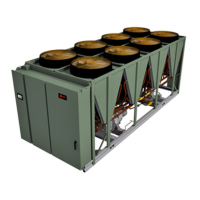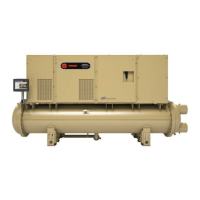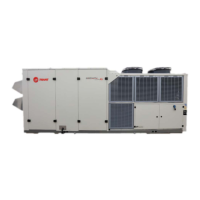68
AC-SVX003A-EN
is controlling the pump), the diagnostic is cleared, the EWP
is re-energized, and normal control resumed.
If evaporator water flow is lost once it had been
established, the EWP relay remains energized and a non-
latching diagnostic is generated. If flow returns, the
diagnostic is cleared and the chiller returns to normal
operation.
In general, when there is either a non-latching or latching
diagnostic, the EWP relay is turned off as though there was
a zero time delay. Exceptions whereby the relay continues
to be energized occur with:
• Low Chilled Water Temperature diagnostic (non-
latching unless also accompanied by an Evap Leaving
Water Temperature Sensor Diagnostic)
OR
• Interrupt Failure —AFDxA diagnostic where x is
either 1 or 2 to indicate which drive is affected), in
which a compressor continues to draw current even
after commanded to have shutdown.
OR
• Loss of Evaporator Water Flow diagnostic (non-
latching) and the unit is in the AUTO mode, after initially
having proven evaporator water flow.
Evaporator Pump Package
When optional evaporator pump package is installed,
Evaporator Pump Control is set to Single Pump Variable
Speed in Tracer® TU. Additional I/Os are required for
Symbio™ 800 to control and monitor the pump VFD.
Symbio 800 monitors the pump speed, fault, and running
status. Two options selectable in Tracer TU are available
for evaporator pump speed control:
• Direct Pump Speed Control (factory default): Uses
Evap Water Pump Speed setpoint configuration from 0
to 100 percent.
• Water Flow Control: Uses Evap Water Flow Rate
setpoint configuration from 50 to 1200 gpm.
For each speed control option, speed or water flow
setpoints are accessible through the AdaptiView™ Display,
Tracer TU, and building automation system.
Note: For the Water Flow Control option, evaporator water
flow measurement must be installed.
Evaporator Flow Measurement
Fluid flow through the chiller evaporator is calculated by
sensing the pressure drop across its heat exchanger. The
heat exchanger pressure drop is determined by measuring
the pressure difference between entering and leaving
pressures in the evaporator water box. Using this sensed
pressure drop, along with coefficients specific to each heat
exchanger, the fluid flow rate through the evaporator is
computed and displayed at the human interface. Once the
flow rate through the evaporator is known, chiller capacity
can be determined. The differential water pressure range is
configurable from 0 to 50 psid.
Three configurable water flow measurement types are
available (selectable in Tracer® TU):
• Differential Pressure (4-20mA input to Trane LLID)
• Flow Meter (4-20mA input to Trane LLID)
• Dual Pressure Sensors (entering and leaving pressure
transducer Trane LLIDs)
Flow calibration points are factory programmed. Contact
technical support for flows and pressure drops used for
flow calibration if Symbio™ 800 required reprogramming in
the field. These setpoints are accessible in Tracer TU.
Programmable Relays
An optional programmable four relay LLID provides hard-
wired interlock of certain events or states of the chiller,
selected from a list of likely needs, as shown in the field
wiring diagram. The relay contacts are single-pole-double-
throw (SPDT) and are suitable for use with 120VAC at 7.2A
resistive, 2.88A pilot duty, and 1/3 HP (7.2A) or with
240VAC at 5A general purpose duty.
The list of events/states that can be assigned to the
programmable relays can be found in the following table.
The relay will be energized when the event/state occurs.
Table 25. Alarm and status relay output
configurations
Description
Alarm
(Latching)
This output is true whenever there is any active
latching shutdown diagnostic that targets the Unit,
Circuit, or any of the Compressors on a circuit.
Alarm
(Non-Latching)
This output is true whenever there is any active
non-latching shutdown diagnostic that targets the
Unit, Circuit, or any of the Compressors on a circuit.
Alarm
This output is true whenever there is any active
latching or non-latching shutdown diagnostic that
targets the Unit, Circuit, or any of the Compressors
on a circuit.
Alarm Ckt 1
This output is true whenever there is any active
latching or non-latching shutdown diagnostic that
targets Circuit 1, or any of the Compressors on
Circuit 1.
Alarm Ckt 2
This output is true whenever there is any active
latching or non-latching shutdown diagnostic that
targets Circuit 2, or any of the Compressors on
Circuit 2.
Unit Limit Mode
This output is true whenever a circuit on the unit
has been running in one of the limit modes
continuously for the Limit Relay debounce time. A
given limit or overlapping of different limits must be
in effect continuously for the debounce time prior to
the output becoming true. It will become false if no
limits are present for the debounce time.
Compressor
Running
The output is true whenever any compressor is
running.
Circuit 1
Running
The output is true whenever any compressor of
Circuit 1 is running.
Installation Electrical

